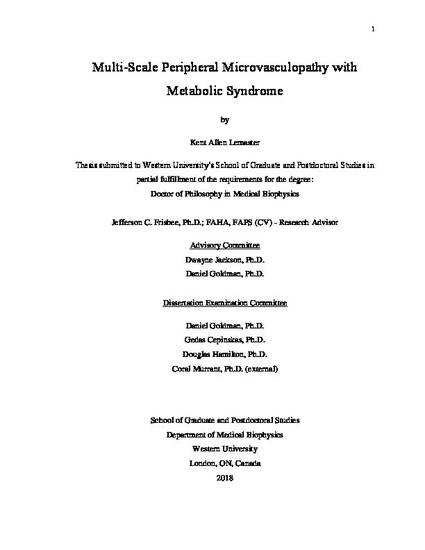
Thesis
Kent_A_Lemaster_PhD-Thesis_Pre-exam submission.docx
(2018)
Abstract
The combination of cardiovascular and metabolic risk factors including obesity, dyslipidemia, hypertension, and insulin resistance, in combination with a prothrombotic and proinflammatory state, is a condition termed Metabolic Syndrome (METS). Twenty percent of the adult population is afflicted with METS which increases the risk of type-2 diabetes mellitus and cardiovascular disease. Further, the presence of peripheral vascular disease (PVD) is tightly coupled with METS which is a perfusion-demand mismatch of blood supply to active skeletal muscle resulting in painful claudication and a late-stage potential for amputation. The underlying contributors of METS associated micro-vasculopathies in the skeletal muscle, their impact on impaired perfusion, and the potential for reversibility remain unclear. Owing its hyperphagia to leptin signaling resistance, the obese Zucker rat (OZR) is a translationally relevant model for human METS and the associated micro-vasculopathies. The overall purpose of this thesis is to utilize a multi-scale approach, particularly intravital microscopy and isolate vessels, to garner a greater understanding of the observed OZR vasculopathies and to investigate the potential of therapeutic interventions for their reversibility.
Project 1:The purpose was to identify any alterations in postcapillary and collecting venule function in the OZR compared to healthy controls. The OZR presented with impaired dilator reactivity and elevation in thromboxane A2 constrictor responses for both postcapillary and collecting venules.
Project 2: The purpose was to identify the possible contributors of a disconnect for in-situ and ex-vivo vascular studies utilizing the OZR model. Using a multi-scale approach, Project 2 provides insight to this disconnect and reveals a heterogenous adrenergic response in the OZR, giving rise to new potential avenues of study.
Project 3: The purpose was to determine the potential for reversibility or restoration of established PVD using the chronic ingestion of an HMG-CoA inhibitor, atorvastatin, and/or the implementation of regular exercise. Following a seven-week intervention, the intervention groups revealed vascular improvements with the combination group having the greatest capacity for reversibility (in specific indices).
Significance: Therefore, this thesis further advances the understanding of METS associated PVD as well as potential modes for improvement following its establishment.
Keywords
- Rodent Model for Metabolic Syndrome,
- Microvasculopathy,
- Peripheral Vascular Disease,
- Venular Function,
- Skeletal Muscle Blood Flow,
- Adrenergic Vascular Responses,
- Reversing Vascular Disease
Disciplines
Publication Date
Winter December 15, 2018
Degree
Ph.D.
Field of study
Microcirculation
Department
Medical Biophysics
Advisor
Jefferson C. Frisbee
Citation Information
Kent Lemaster. "Kent_A_Lemaster_PhD-Thesis_Pre-exam submission.docx" (2018) Available at: http://works.bepress.com/kent-lemaster/1/